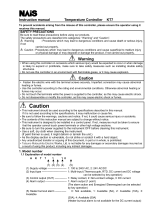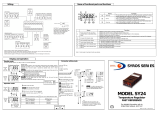Heating-side control output
1
2
3
NC
NO
COM
Relay contact output
* Time proportional PID relay contact output
is configured at factory before shipment.
* Available if 4, 7 or 10 is set in the OT
(Control Output Type) setup parameter.
Contact rating: 250 V AC, 3 A
30 V DC, 3 A (resistance load)
23
24
25
26
27
SDB(+)
SDA(-)
RDB(+)
RDA(-)
SG
* Wiring can only be carried out
for controllers with communication
functions.
Maximum baud rate: 9600 bps
RS-485 communication
12
13
11
12
13
12
13
A
b
B
+
-
+
-
TC input
RTD input
mV/V input
Installation category (overvoltage category): II (IEC1010-1)
NOTE
12
13
*
When receiving 4-20 mA DC current signals,
set the PV input type to 1-5 V DC (setpoint
“41”).
䊏
Receiving 4-20 mA DC Current
Signals with the Controller
250 Ω
4-20mA
-
+
Note: Connecting a 250
Ω resistor to the terminals is
optional.
Model: X010-250-2 (resistor with M3.5 crimp-on terminal
lugs)
PV input
* Not configured at factory before shipment
See “2. Initial Settings,
” for more
information.
Heating-side control output
16
17
Current/voltage
pulse output
4-20 mA DC,
voltage pulse
(12 V)
+
-
* Available if 5, 6, 8, 9, 11
or 12 is set in the OT
(Control Output
Type) setup parameter.
14
15
14
15
+
-
+
-
Retransmission output
4-20 mA DC
14
15
+
-
4-20 mA DC,
voltage pulse (12 V)
15 V DC loop power supply
14.5-18.0VDC
(21 mA DC max.)
Cooling-side control output
8
9
10
L
N
Power supply
Power supply
Allowable range: 100 to 240 V AC (
10%)
(free voltage)
50/60 Hz shared
6
5
4
7
AL1
AL2
AL3
COM
Relay
Alarm output/cooling-side control output
Alarm-1 output
Alarm-2 output
Alarm-3 output
or cooling-side control
output (Note)
Common
Relay contact rating: 240 V AC, 1 A
30 V DC, 1 A (
resistance
load)
UT
When switching target
setpoints 1 to 4:
DI1
DI2
1.SP
2.SP3.SP
4.SP
OFF
OFFOFF
ON ON
ON
OFF
ON
Contact rating: 12 V DC, 10 mA or more
Correspondence between parameter DIS and external contact input functions
When DIS=4
DI1
DI2
COM
Common
When DIS=3
2.SP when DI1=ON
1.SP when DI1=OFF
STOP when DI2=ON
RUN when DI2=OFF
Common
When DIS=2
Hides the LOCK parameter when DI1=ON.
Shows the LOCK parameter when DI1=OFF.
Common
When DIS=1 (Factory-set default)
2.SP when DI1=ON
1.SP when DI1=OFF
AUTO when DI2=ON
MAN when DI2=OFF
Common
When DIS=OFF
No function
No function
Common
DI1
DI2
COM
+5V
+5V
Contact
Transistor contact
*
DIS is a setup parameter.
Changing DIS setpoint allows you to change the function of external contact input.
No function
19
18
20
UT
19
18
20
OT=4 (factory-set default) OT=5
Correspondence between parameter OT and heating-side/cooling-side output types
OT=6
OT=7 OT=8 OT=9 OT=10 OT=11 OT=12
* OT is a setup parameter. You can change the settings of the parameter OT to change the control output type.
See “2. Initial Settings,
” for more information.
The control output types,
“relay output
” and “voltage pulse output
” shown in the table above refer to those of time proportional control.
To change the type to a relay output for on-off control, select
“Relay Terminals
” and change the setpoint of the proportional band to
“0.”
Heating side: Relay output
(terminals , and )
Cooling side: Relay output
(terminals and )
1
2
3
Heating side: Voltage pulse output
(terminals and )
Cooling side: Relay output
(terminals and )
16 17
Heating side: Current output
(terminals and )
Cooling side: Relay output
(terminals and )
16
17
14 15
14 15
14
15
14 15
14
15
14
15
Heating side: Relay output
(terminals , and )
Cooling side: Voltage pulse output
(terminals and )
1
2
3
Heating side: Relay output
(terminals , and )
Cooling side: Current output
(terminals and )
1
2
3
Heating side: Voltage pulse output
(terminals and )
Cooling side: Voltage pulse output
(terminals and )
16 17
Heating side: Current output
(terminals and )
Cooling side: Voltage pulse output
(terminals and )
16
17
Heating side: Voltage pulse output
(terminals and )
Cooling side: Current output
(terminals and )
16 17
Heating side: Current output
(terminals and )
Cooling side: Current output
(terminals and )
16
17
4
7
4
7
4
7
Note: The cooling-side control output is selected if 4, 5 or
6 is set in the OT (Control Output Type) setup
parameter. The alarm-3 output is not available.
The controller is factory-set to the cooling-side control
output (time proportional PID relay contact output).
* PV retransmission is configured at factory before shipment.
* If 15 V DC loop power supply is used,
retransmission output cannot be used.
* The retransmission output and 15 V DC
loop power supply are not available if
the cooling-side control output is set to
“current output
” and “voltage pulse output.
”
29
28
Heater current
detection input
30
CT2
CT1
COM
CT
CT
* This wiring is only possible
for a controller with a heater
burnout alarm.
Note: External Contact Input
If the power is turned on
when the external contact
input is OFF, the mode
(SP.no or A/M) existing
before the power is turned
off will be continued.
(except for RUN/STOP)
1
2
3
4
5
6
7
8
9
10
21
22
23
24
25
26
27
28
29
30
11
12
13
14
15
16
17
18
19
20
CAUTION
Before carrying out wiring, turn off the power
to the controller and check that cables to be
connected are not alive with a tester or the like
because there is a possibility of electric shock.























